Attached files
| file | filename |
|---|---|
| 8-K - 8-K - INVESTOR PRESENTATION MAY 9 2017 - POTLATCHDELTIC CORP | pch-8k_20170509.htm |
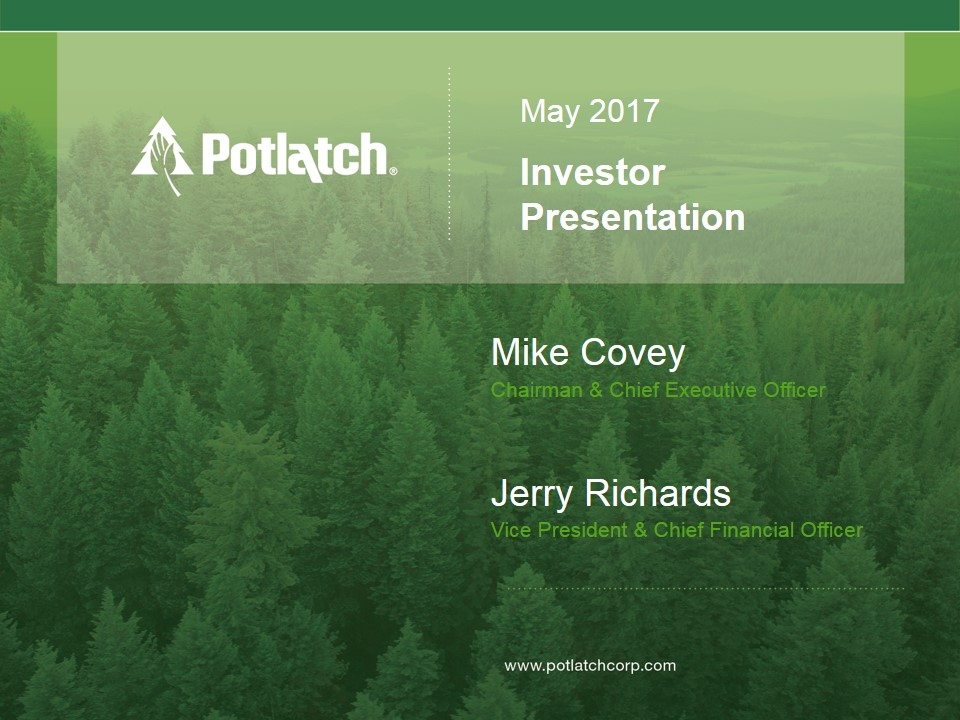
May 2017 Investor Presentation Mike Covey Chairman & Chief Executive Officer Jerry Richards Vice President & Chief Financial Officer www.potlatchcorp.com
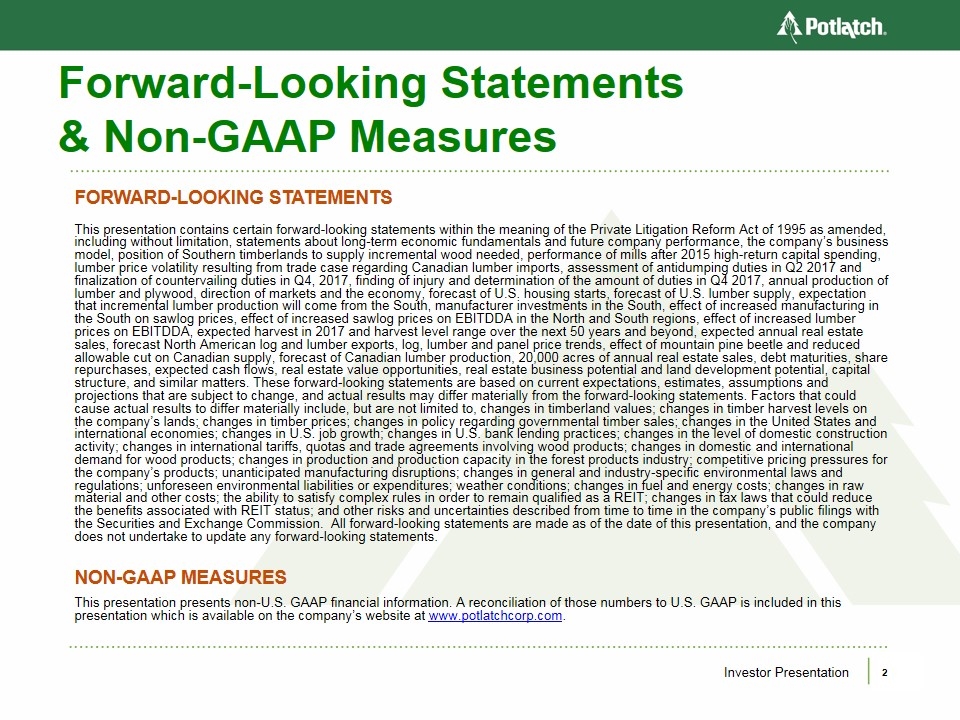
Forward-Looking Statements & Non-GAAP Measures FORWARD-LOOKING STATEMENTS This presentation contains certain forward-looking statements within the meaning of the Private Litigation Reform Act of 1995 as amended, including without limitation, statements about long-term economic fundamentals and future company performance, the company’s business model, position of Southern timberlands to supply incremental wood needed, performance of mills after 2015 high-return capital spending, lumber price volatility resulting from trade case regarding Canadian lumber imports, assessment of antidumping duties in Q2 2017 and finalization of countervailing duties in Q4, 2017, finding of injury and determination of the amount of duties in Q4 2017, annual production of lumber and plywood, direction of markets and the economy, forecast of U.S. housing starts, forecast of U.S. lumber supply, expectation that incremental lumber production will come from the South, manufacturer investments in the South, effect of increased manufacturing in the South on sawlog prices, effect of increased sawlog prices on EBITDDA in the North and South regions, effect of increased lumber prices on EBITDDA, expected harvest in 2017 and harvest level range over the next 50 years and beyond, expected annual real estate sales, forecast North American log and lumber exports, log, lumber and panel price trends, effect of mountain pine beetle and reduced allowable cut on Canadian supply, forecast of Canadian lumber production, 20,000 acres of annual real estate sales, debt maturities, share repurchases, expected cash flows, real estate value opportunities, real estate business potential and land development potential, capital structure, and similar matters. These forward-looking statements are based on current expectations, estimates, assumptions and projections that are subject to change, and actual results may differ materially from the forward-looking statements. Factors that could cause actual results to differ materially include, but are not limited to, changes in timberland values; changes in timber harvest levels on the company’s lands; changes in timber prices; changes in policy regarding governmental timber sales; changes in the United States and international economies; changes in U.S. job growth; changes in U.S. bank lending practices; changes in the level of domestic construction activity; changes in international tariffs, quotas and trade agreements involving wood products; changes in domestic and international demand for wood products; changes in production and production capacity in the forest products industry; competitive pricing pressures for the company’s products; unanticipated manufacturing disruptions; changes in general and industry-specific environmental laws and regulations; unforeseen environmental liabilities or expenditures; weather conditions; changes in fuel and energy costs; changes in raw material and other costs; the ability to satisfy complex rules in order to remain qualified as a REIT; changes in tax laws that could reduce the benefits associated with REIT status; and other risks and uncertainties described from time to time in the company’s public filings with the Securities and Exchange Commission. All forward-looking statements are made as of the date of this presentation, and the company does not undertake to update any forward-looking statements. NON-GAAP MEASURES This presentation presents non-U.S. GAAP financial information. A reconciliation of those numbers to U.S. GAAP is included in this presentation which is available on the company’s website at www.potlatchcorp.com. Investor Presentation 2
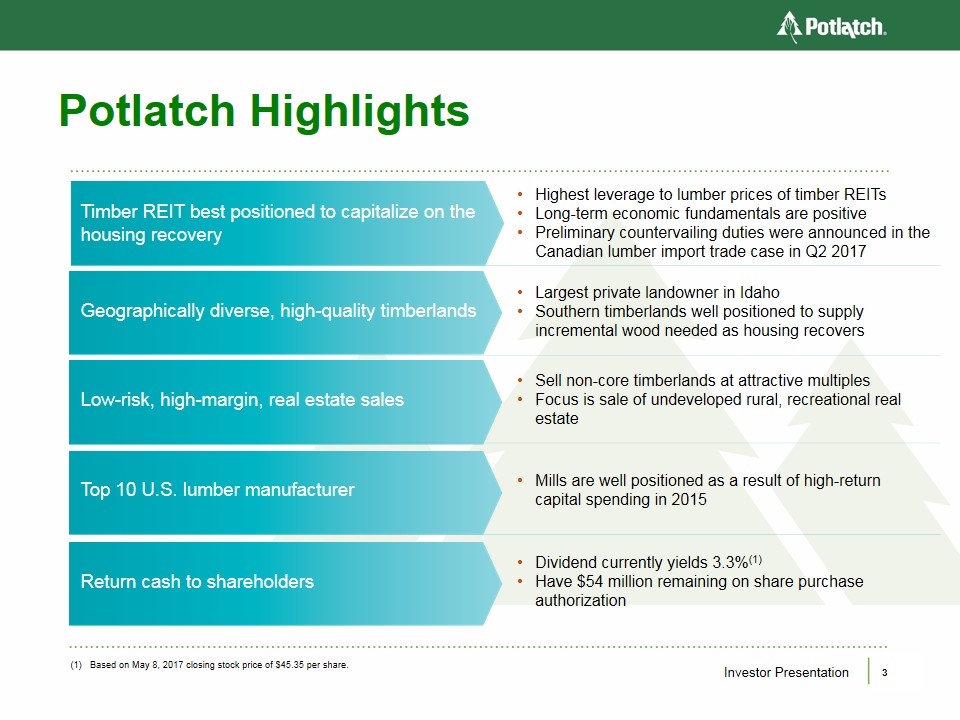
Potlatch Highlights Timber REIT best positioned to capitalize on the housing recovery Highest leverage to lumber prices of timber REITs Long-term economic fundamentals are positive Preliminary countervailing duties were announced in the Canadian lumber import trade case in Q2 2017 Geographically diverse, high-quality timberlands Largest private landowner in Idaho Southern timberlands well positioned to supply incremental wood needed as housing recovers Low-risk, high-margin, real estate sales Sell non-core timberlands at attractive multiples Focus is sale of undeveloped rural, recreational real estate Top 10 U.S. lumber manufacturer Mills are well positioned as a result of high-return capital spending in 2015 Return cash to shareholders Dividend currently yields 3.3%(1) Have $54 million remaining on share purchase authorization (1) Based on May 8, 2017 closing stock price of $45.35 per share. Investor Presentation 3
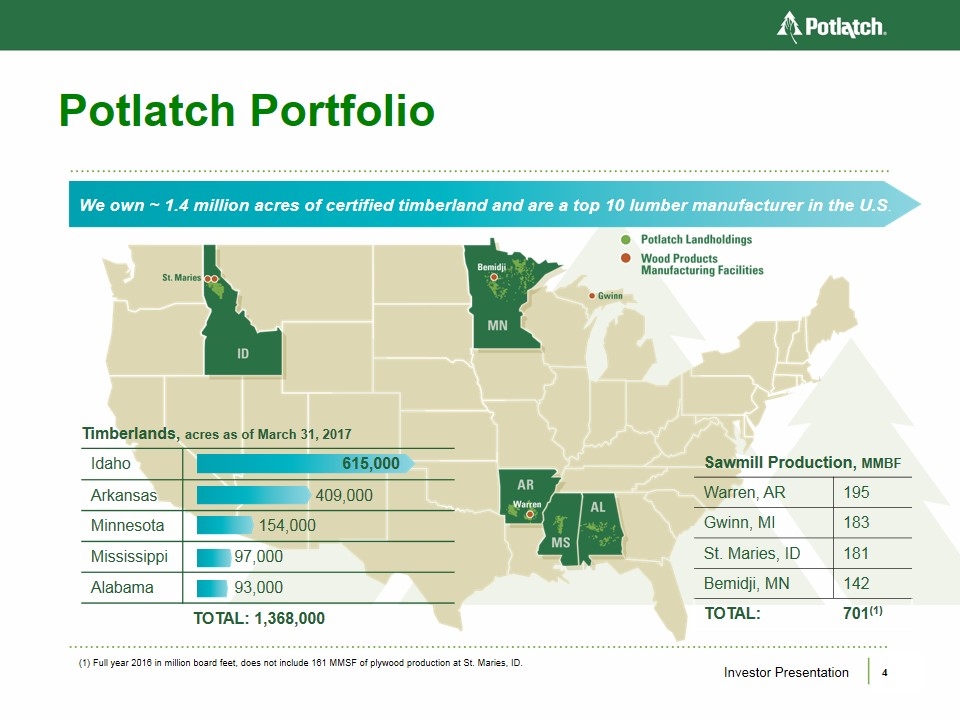
Potlatch Portfolio Idaho 615,000 Arkansas 409,000 Minnesota 154,000 Mississippi 97,000 Alabama 93,000 TOTAL: 1,368,000 We own ~ 1.4 million acres of certified timberland and are a top 10 lumber manufacturer in the U.S. Timberlands, acres as of March 31, 2017 (1) Full year 2016 in million board feet, does not include 161 MMSF of plywood production at St. Maries, ID. Sawmill Production, MMBF Warren, AR 195 Gwinn, MI 183 St. Maries, ID 181 Bemidji, MN 142 TOTAL: 701(1) Investor Presentation 4 St.Maries Bemidji ID MN Potlatch Landholdings Wood Products Manufacturing Facilities AR Warren MS AL Wood Products Manufacturings Facilities gwinn
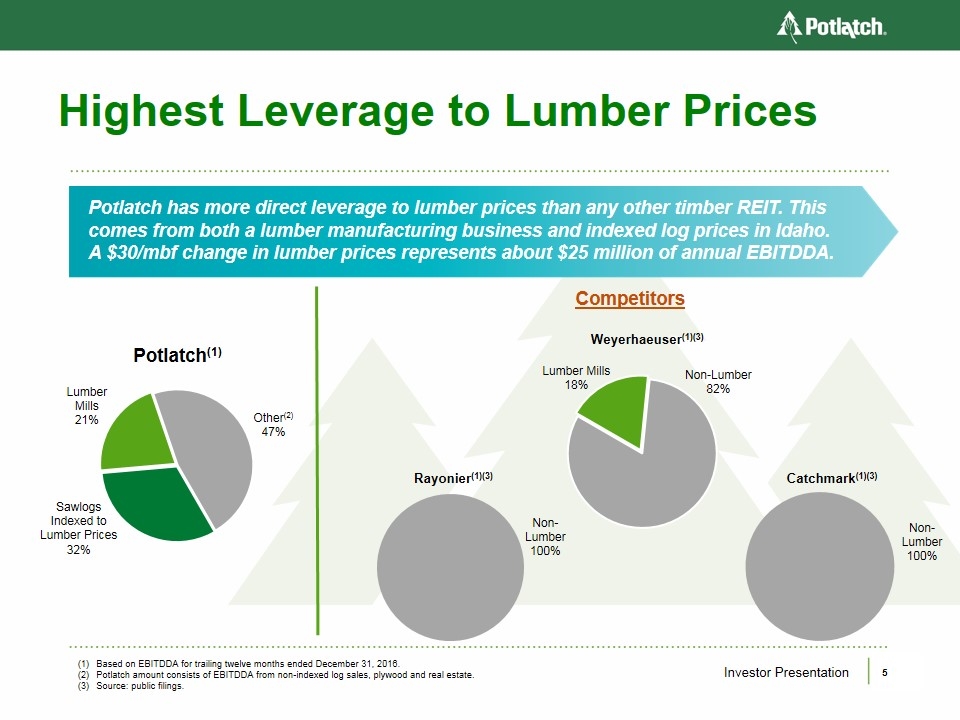
Highest Leverage to Lumber Prices Potlatch has more direct leverage to lumber prices than any other timber REIT. This comes from both a lumber manufacturing business and indexed log prices in Idaho. A $30/mbf change in lumber prices represents about $25 million of annual EBITDDA. Based on EBITDDA for trailing twelve months ended December 31, 2016. Potlatch amount consists of EBITDDA from non-indexed log sales, plywood and real estate. Source: public filings. Competitors Sawlogs Indexed to Lumber Prices 32% Investor Presentation 5 Potlatch(1) Lumber Mills 21% Other(2) 47% Weyerhaeuser(1)(3) Lumber Mills 18% Non-Lumber 82% Rayonier(1)(3) Non-Lumber 100% Catchmark(1)(3) Non-Lumber 100% Competitors Lumber mills 21% Other(2) 47%
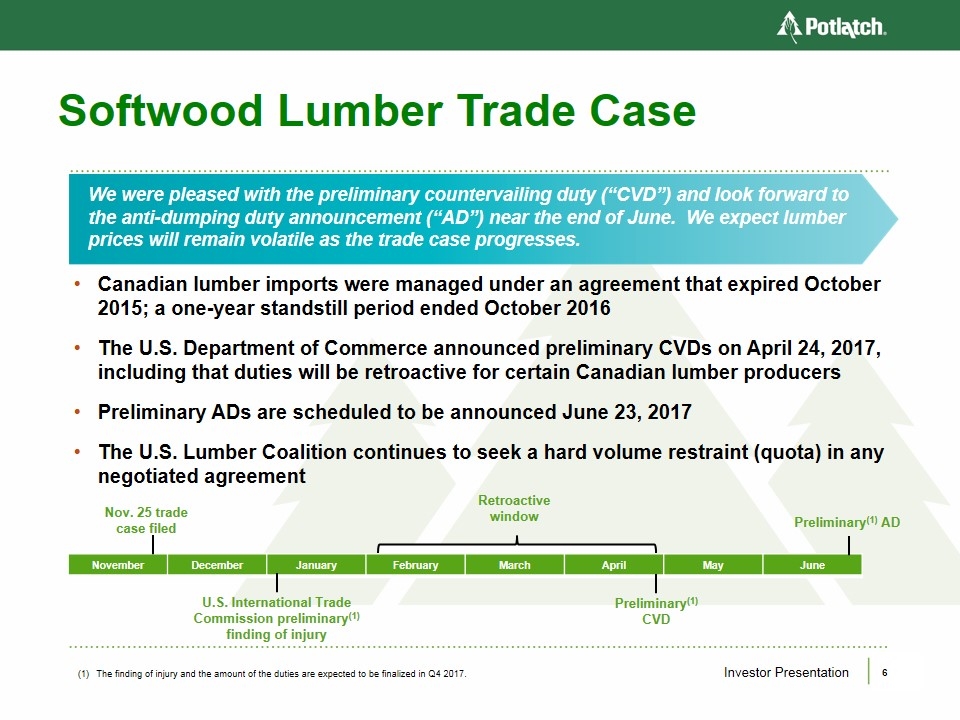
Softwood Lumber Trade Case We were pleased with the preliminary countervailing duty (“CVD”) and look forward to the anti-dumping duty announcement (“AD”) near the end of June. We expect lumber prices will remain volatile as the trade case progresses. Canadian lumber imports were managed under an agreement that expired October 2015; a one-year standstill period ended October 2016 The U.S. Department of Commerce announced preliminary CVDs on April 24, 2017, including that duties will be retroactive for certain Canadian lumber producers Preliminary ADs are scheduled to be announced June 23, 2017 The U.S. Lumber Coalition continues to seek a hard volume restraint (quota) in any negotiated agreement November December January February March April May June Nov. 25 trade case filed U.S. International Trade Commission preliminary(1) finding of injury Preliminary(1) CVD Preliminary(1) AD Retroactive window The finding of injury and the amount of the duties are expected to be finalized in Q4 2017. Investor Presentation 6 Potlatch
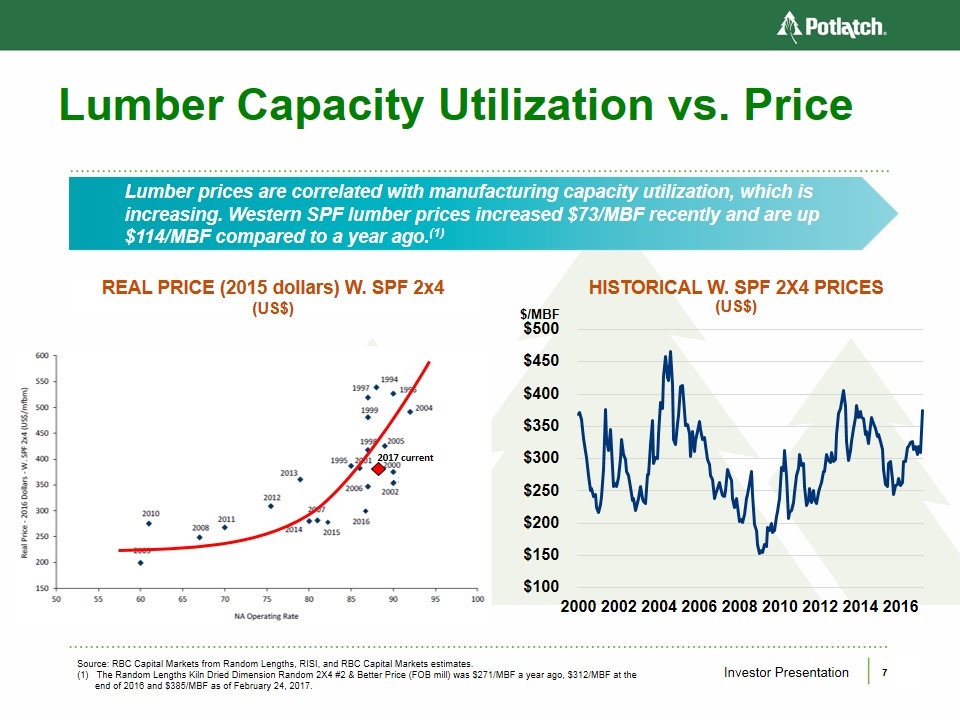
Lumber Capacity Utilization vs. Price Lumber prices are correlated with manufacturing capacity utilization, which is increasing. Western SPF lumber prices increased $73/MBF recently and are up $114/MBF compared to a year ago.(1) Source: RBC Capital Markets from Random Lengths, RISI, and RBC Capital Markets estimates. (1) The Random Lengths Kiln Dried Dimension Random 2X4 #2 & Better Price (FOB mill) was $271/MBF a year ago, $312/MBF at the end of 2016 and $385/MBF as of February 24, 2017. $/MBF REAL PRICE (2015 dollars) W. SPF 2x4 (US$) 2017 current Investor Presentation 7 50 55 60 65 70 75 80 85 90 95 100 150 200 250 300 350 400 450 500 550 600 1994 1995 1996 1997 1998 1999 2000 2001 2002 2003 2004 2005 2006 2007 2008 2009 2010 2011 2012 2013 2014 2015 2016 2017 Current $/MBF Real Price – 2016 Dollars – W. SPF 2x4 (US$/mfbm) Real Price (2015 dollars) W. SPF 2x4 (US$) Historical W. SPF 2x4 Prices (US$) $
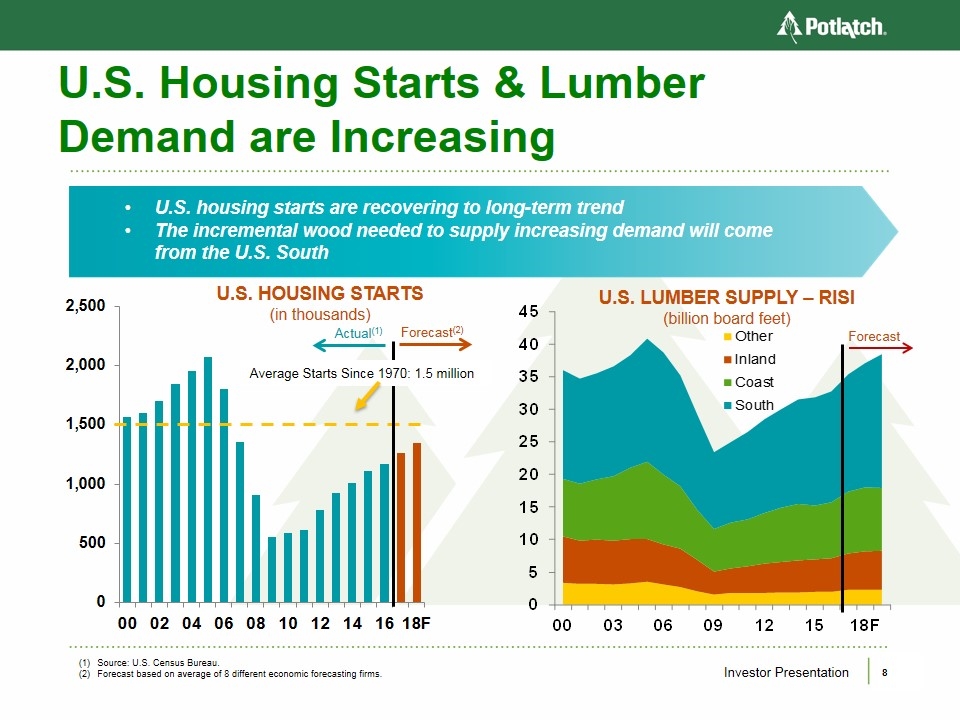
U.S. Housing Starts & Lumber Demand are Increasing U.S. housing starts are recovering to long-term trend The incremental wood needed to supply increasing demand will come from the U.S. South Forecast(2) Actual(1) U.S. HOUSING STARTS (in thousands) U.S. LUMBER SUPPLY – RISI (billion board feet) Average Starts Since 1970: 1.5 million Forecast Source: U.S. Census Bureau. Forecast based on average of 8 different economic forecasting firms. Other Inland Coast South 2,500 2,000 1,500 1,000 500 0 00 02 04 06 08 10 12 14 16 18F 45 40 35 30 25 20 15 10 5 0 00 03 06 09 12 15 18F Investor Presentation 8
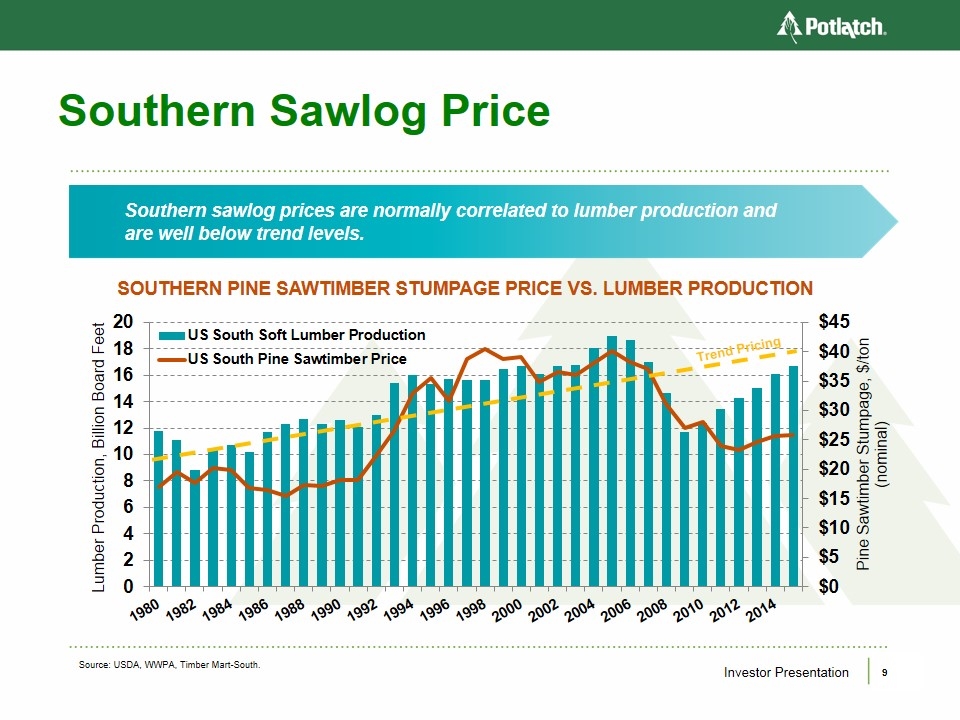
Southern Sawlog Price Southern sawlog prices are normally correlated to lumber production and are well below trend levels. SOUTHERN PINE SAWTIMBER STUMPAGE PRICE VS. LUMBER PRODUCTION Source: USDA, WWPA, Timber Mart-South. Trend Pricing US South Soft Lumber production US South Pine Sawtimber Price Trend Pricing 20 18 16 14 12 10 8 6 4 2 0 1980 1982 1984 1986 1988 1990 1992 1994 1996 1998 2000 2002 2004 2006 2008 2010 2012 2014 $ 45 40 35 30 25 20 15 10 5 0 Pine Sawtimber Stumpage, $/ton (nominal) Lumber production, Billion board feet Investor Presentation 9
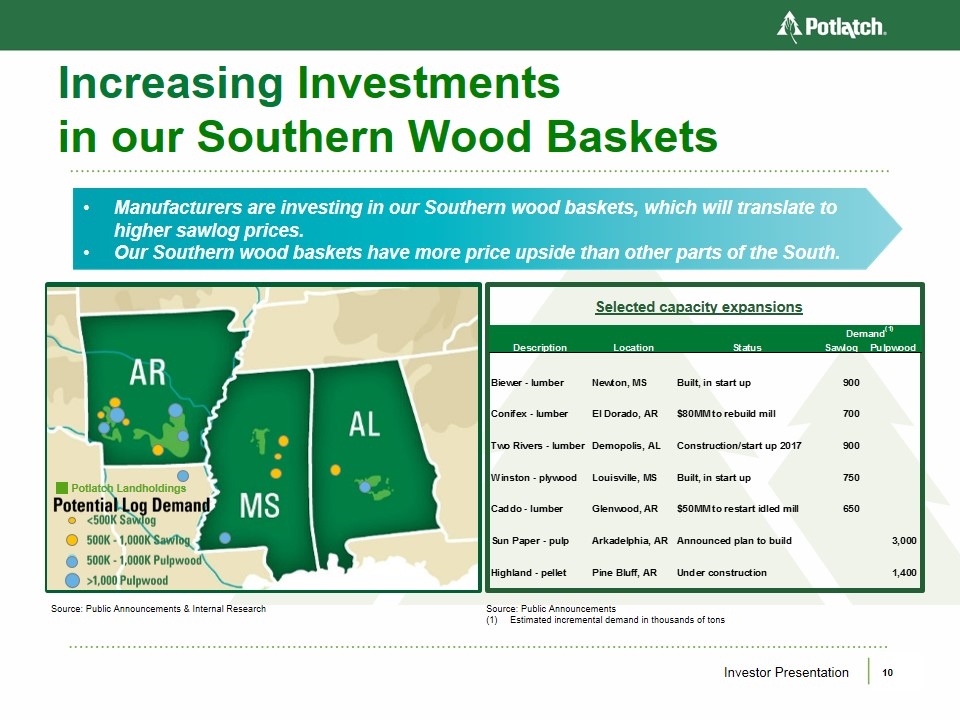
Increasing Investments in our Southern Wood Baskets Manufacturers are investing in our Southern wood baskets, which will translate to higher sawlog prices. Our Southern wood baskets have more price upside than other parts of the South. Source: Public Announcements & Internal Research Source: Public Announcements (1)Estimated incremental demand in thousands of tons Selected capacity expansions Potlatch Landholdings AR MS AL <500K Sawlog 500k – 1,000K Sawlog 500K – 1,000 Pulpwood >1,000 Pulpwood Potential Log Demand Investor Presentation 10 Demand(1) Description Location Status Sawlog Pulpwood Biewer - lumber Newton, MS Built, in start up 900 Conifex - lumber El Dorado, AR $80MM to rebuild mill 700 Two Rivers - lumber Demopolis, AL Construction/start up 2017 900 Winston - plywood Louisville, MS Built, in start up 750 Caddo - lumber Glenwood, AR $50MM to restart idled mill 650 Sun Paper - pulp Arkadelphia, AR Announced plan to build 3,000 Highland - pellet Pine Bluff, AR Under construction 1,400
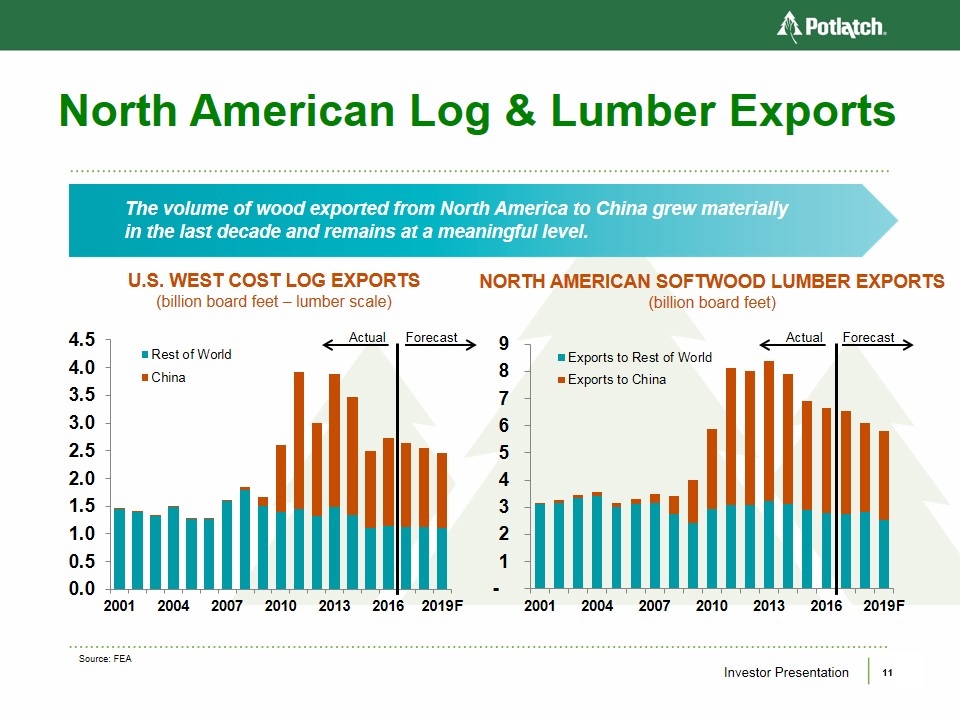
North American Log & Lumber Exports The volume of wood exported from North America to China grew materially in the last decade and remains at a meaningful level. U.S. WEST COST LOG EXPORTS (billion board feet – lumber scale) NORTH AMERICAN SOFTWOOD LUMBER EXPORTS (billion board feet) Forecast Actual Forecast Actual Source: FEA Rest of world China Exports to 4.5 4.0 3.5 3.0 2.5 2.0 1.5 1.0 0.5 0.0 9 8 7 6 5 4 3 2 1 - 2001 2004 2007 2010 2013 2016 2019F Investor Presentation 11
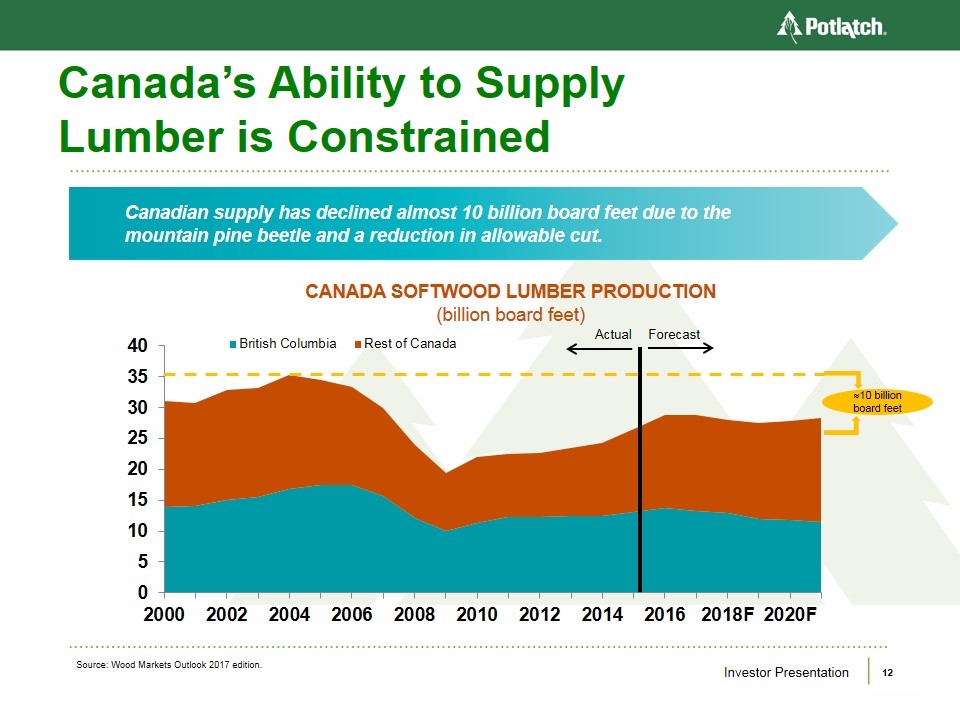
Canada’s Ability to Supply Lumber is Constrained Canadian supply has declined almost 10 billion board feet due to the mountain pine beetle and a reduction in allowable cut. CANADA SOFTWOOD LUMBER PRODUCTION (billion board feet) Actual Forecast ≈10 billion board feet Source: Wood Markets Outlook 2017 edition. Investor Presentation 12 40 35 25 20 15 10 5 0 2000 2002 2004 2006 2008 2010 2012 2014 2016 2018F 2020F British Columbia Rest of Canada
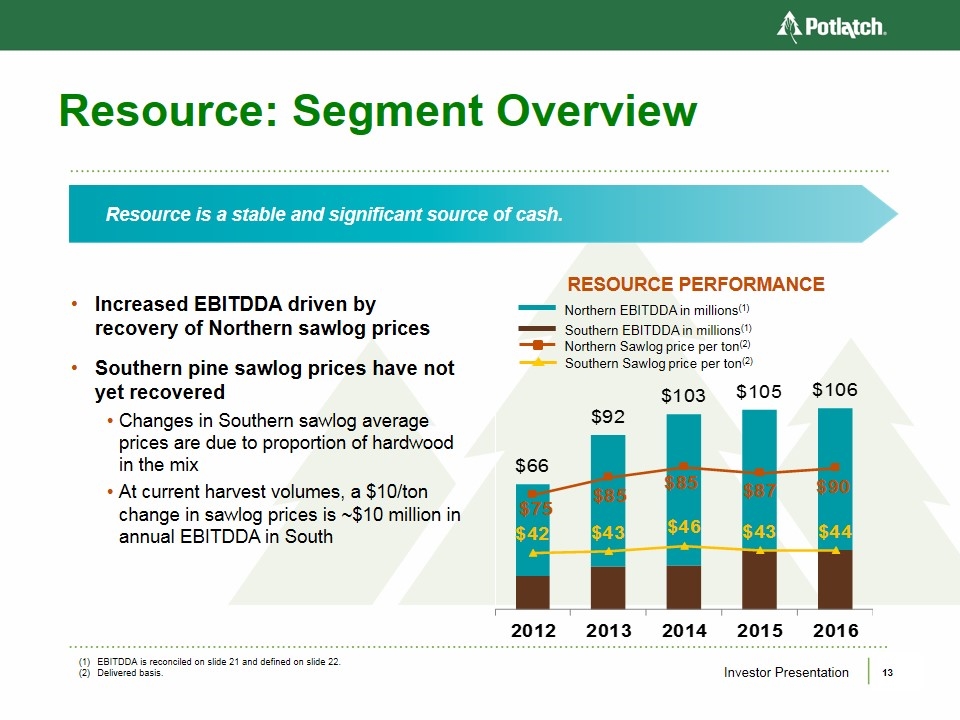
Resource: Segment Overview Resource is a stable and significant source of cash. RESOURCE PERFORMANCE Increased EBITDDA driven by recovery of Northern sawlog prices Southern pine sawlog prices have not yet recovered Changes in Southern sawlog average prices are due to proportion of hardwood in the mix At current harvest volumes, a $10/ton change in sawlog prices is ~$10 million in annual EBITDDA in South EBITDDA is reconciled on slide 21 and defined on slide 22. Delivered basis. Southern EBITDDA in millions(1) Northern Sawlog price per ton(2) Southern Sawlog price per ton(2) Northern EBITDDA in millions(1) Investor Presentation 13 $ 66 92 103 105 106 75 85 85 87 90 42 43 46 43 44 2012 2013 2014 2015 2016 Year N EBITDDA S EBITDDA EBITDDA(1) (in millions) Northern Sawlog (2) (price per ton) Southern Sawlog (2) (price per ton) 2006 $92 2007 $97 $88 $56 2008 $95 $80 $48 2009 $56 $59 $43 2010 $83 $67 $45 2011 $77 $73 $42 2012 48.283617499999998 17.705046500000002 $66 $75 $42 2013 68.869409609999991 22.658954030000004 $92 $85 $43 2014 79.8170219 23.006077649999995 $103 $91 $46 2015 74.099999999999994 31 $105.1 $87.454037167662918 $43.486753991050271 2016 74.599999999999994 31.4 $106 $90.296952963318688 $43.683106681779186
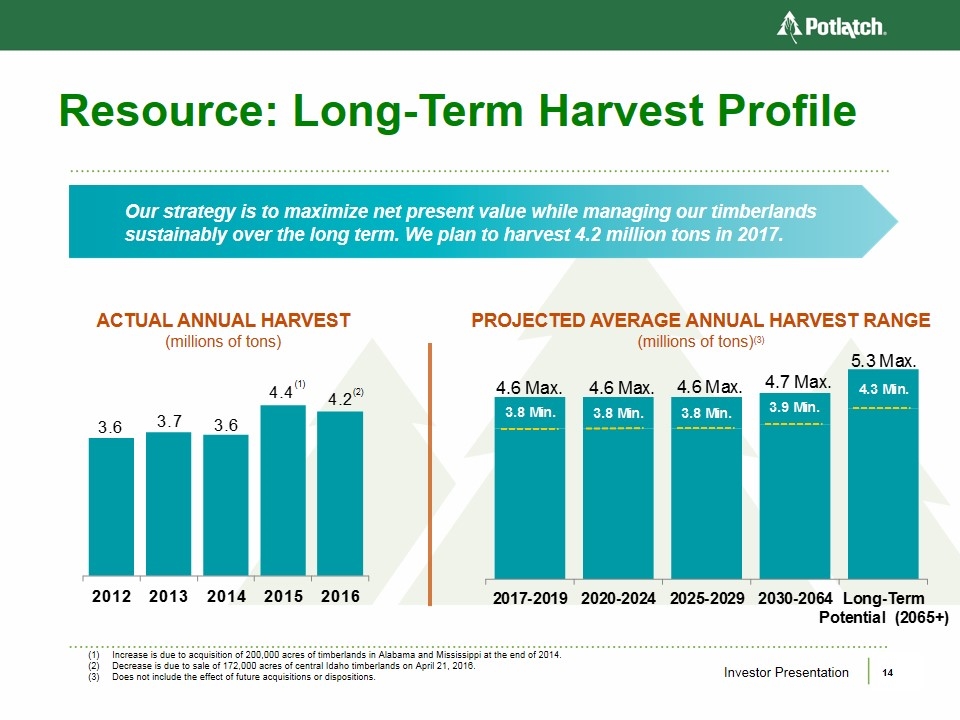
Resource: Long-Term Harvest Profile Our strategy is to maximize net present value while managing our timberlands sustainably over the long term. We plan to harvest 4.2 million tons in 2017. ACTUAL ANNUAL HARVEST (millions of tons) PROJECTED AVERAGE ANNUAL HARVEST RANGE (millions of tons)(3) Increase is due to acquisition of 200,000 acres of timberlands in Alabama and Mississippi at the end of 2014. Decrease is due to sale of 172,000 acres of central Idaho timberlands on April 21, 2016. Does not include the effect of future acquisitions or dispositions. (1) (2) Investor Presentation 14 3.6 3.7 3.6 4.4 4.2 (1) (2) 2012 2013 2014 2015 2016 4.6 MAX 4.6 4.7 5.3 3.8 Min. 3.8 3.9 4.3 2017-2019 2020-2024 2025-2029 2030-2064 Long-Term potential (2065+)
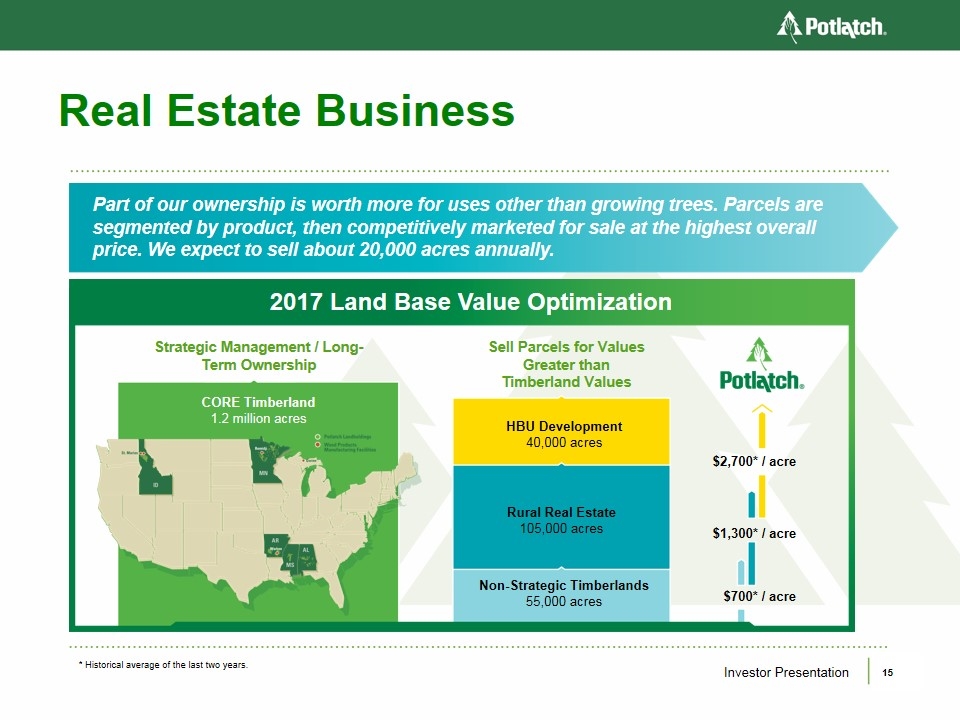
Real Estate Business Part of our ownership is worth more for uses other than growing trees. Parcels are segmented by product, then competitively marketed for sale at the highest overall price. We expect to sell about 20,000 acres annually. * Historical average of the last two years. 2017 Land Base Value Optimization Strategic Management / Long-Term Ownership Sell Parcels for Values Greater than Timberland Values HBU Development 40,000 acres Rural Real Estate 105,000 acres Non-Strategic Timberlands 55,000 acres $2,700* / acre $1,300* / acre $700* / acre CORE Timberland 1.2 million acres Investor Presentation 15 Potlatch St.Maries Bemidji ID MN Potlatch Landholdings Wood Products Manufacturing Facilities AR Warren MS AL Wood Products Manufacturings Facilities gwinn
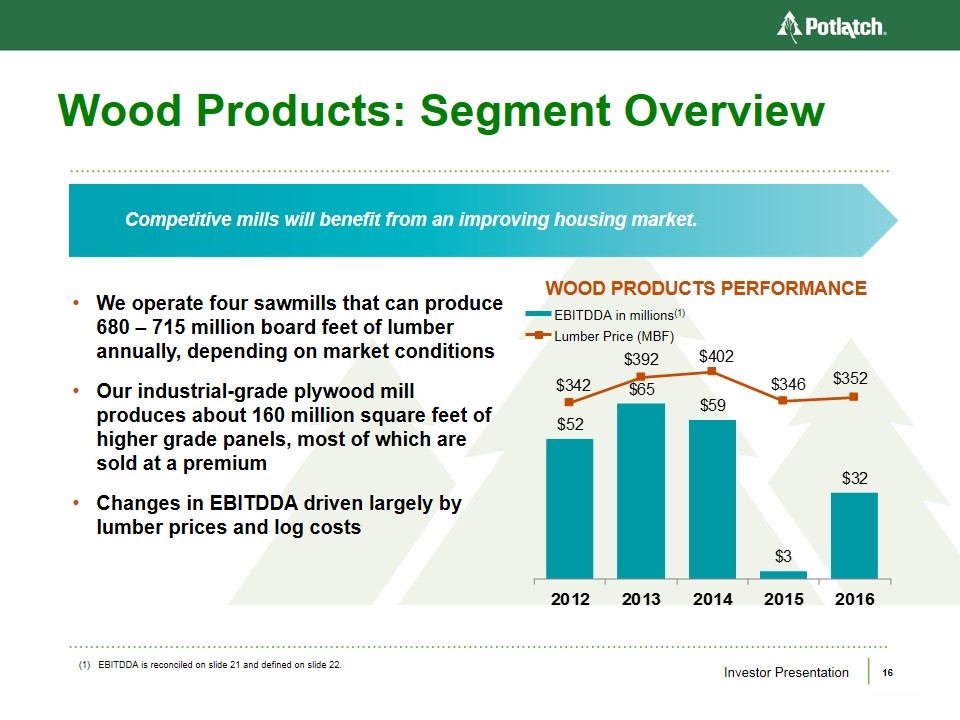
Wood Products: Segment Overview We operate four sawmills that can produce 680 – 715 million board feet of lumber annually, depending on market conditions Our industrial-grade plywood mill produces about 160 million square feet of higher grade panels, most of which are sold at a premium Changes in EBITDDA driven largely by lumber prices and log costs EBITDDA in millions(1) Lumber Price (MBF) Competitive mills will benefit from an improving housing market. WOOD PRODUCTS PERFORMANCE (1) EBITDDA is reconciled on slide 21 and defined on slide 22. Investor Presentation 16 $ 342 392 402 346 352 52 65 59 3 32 2012 2013 2014 2015 2016 Year EBITDDA(1) (in millions) Lumber Price (MBF) 2007 $14 $319 2008 $-4 $292 2009 $-11 $255 2010 $15 $297 2011 $15 $297 2012 $52 $342 2013 $65 $392 2014 $59 $402 2015 $3 $346 2016 $31.938351799999996 $352.39
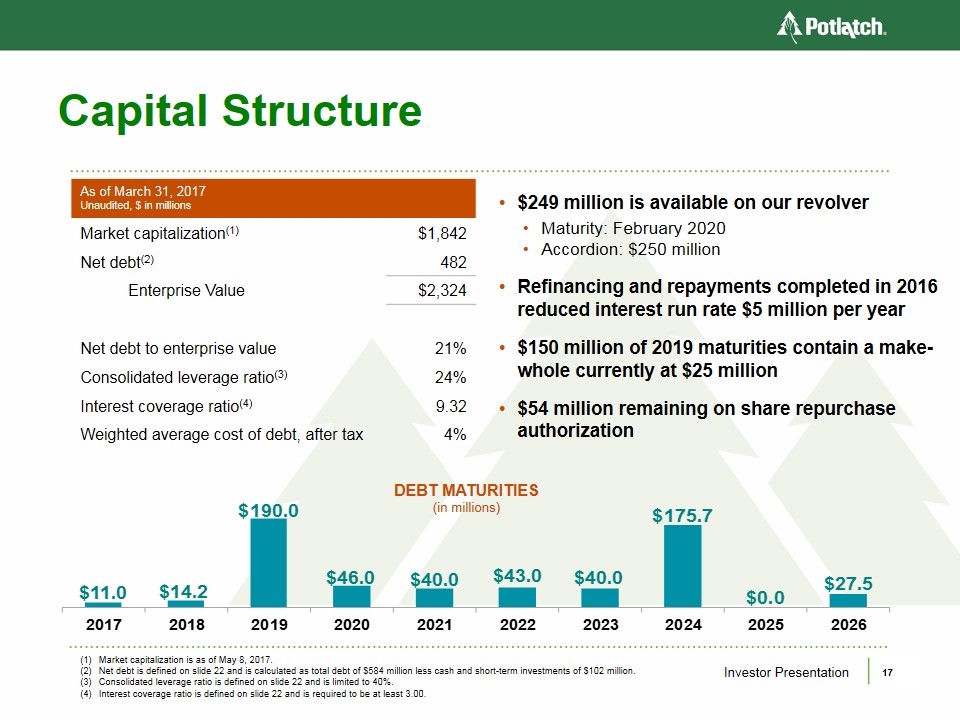
Capital Structure As of March 31, 2017 Unaudited, $ in millions Market capitalization(1) $1,842 Net debt(2) 482 Enterprise Value $2,324 Net debt to enterprise value 21% Consolidated leverage ratio(3) 24% Interest coverage ratio(4) 9.32 Weighted average cost of debt, after tax 4% Market capitalization is as of May 8, 2017. Net debt is defined on slide 22 and is calculated as total debt of $584 million less cash and short-term investments of $102 million. Consolidated leverage ratio is defined on slide 22 and is limited to 40%. Interest coverage ratio is defined on slide 22 and is required to be at least 3.00. $249 million is available on our revolver Maturity: February 2020 Accordion: $250 million Refinancing and repayments completed in 2016 reduced interest run rate $5 million per year $150 million of 2019 maturities contain a make-whole currently at $25 million $54 million remaining on share repurchase authorization DEBT MATURITIES (in millions) Investor Presentation 17 $ 11.0 14.2 190.0 46.0 40.0 43.0 40.0 175.7 0.0 27.5 2017 2018 2019 2020 2021 2022 2023 2024 2025 2026
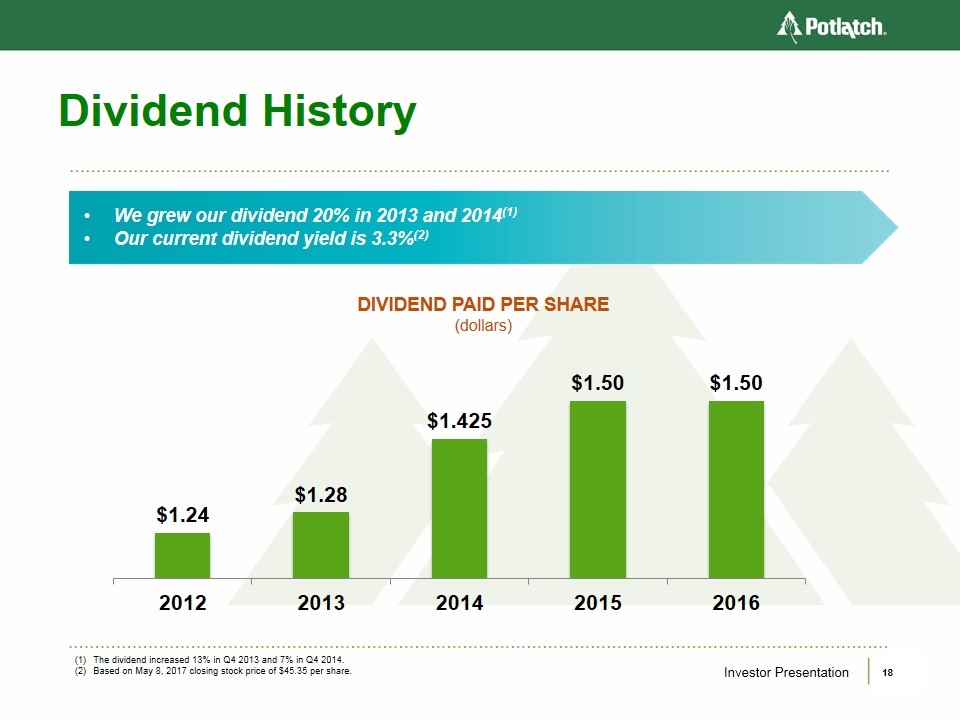
Dividend History DIVIDEND PAID PER SHARE (dollars) We grew our dividend 20% in 2013 and 2014(1) Our current dividend yield is 3.3%(2) The dividend increased 13% in Q4 2013 and 7% in Q4 2014. Based on May 8, 2017 closing stock price of $45.35 per share. Investor Presentation 18 1.24 1.28 1.425 1.50 1.50 2012 2013 2014 2015 2016
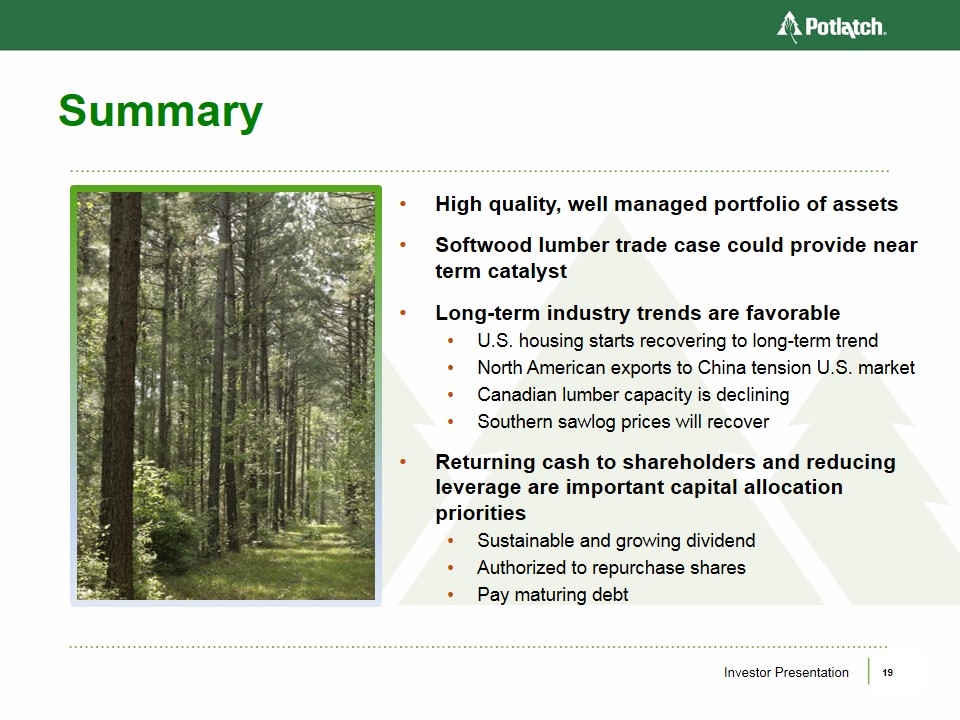
Summary High quality, well managed portfolio of assets Softwood lumber trade case could provide near term catalyst Long-term industry trends are favorable U.S. housing starts recovering to long-term trend North American exports to China tension U.S. market Canadian lumber capacity is declining Southern sawlog prices will recover Returning cash to shareholders and reducing leverage are important capital allocation priorities Sustainable and growing dividend Authorized to repurchase shares Pay maturing debt Investor Presentation 19
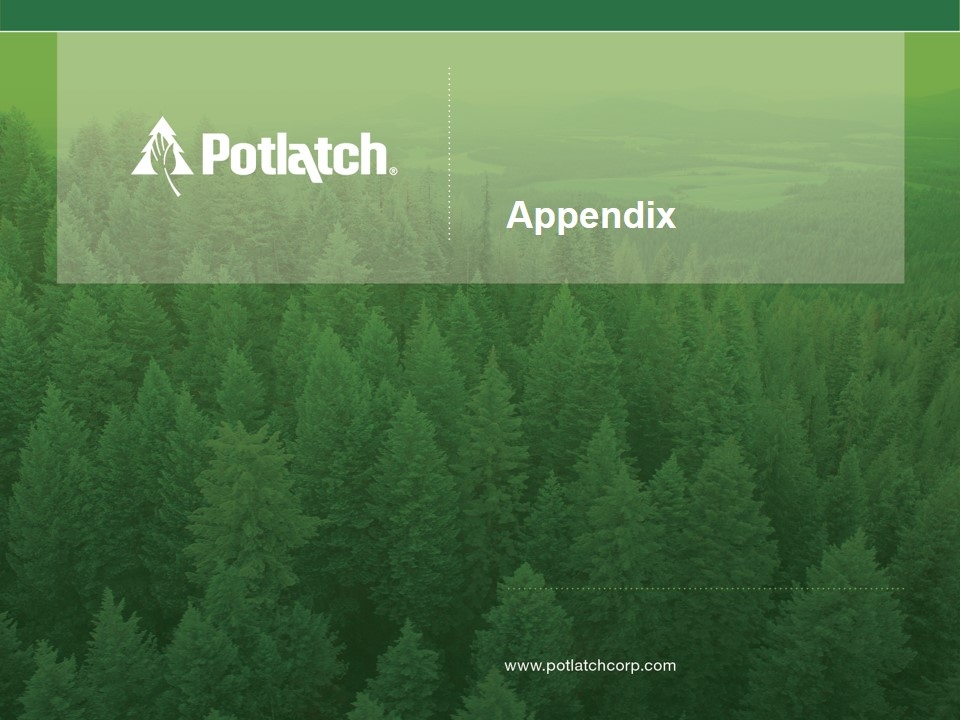
Appendix www.potlatchcorp.com
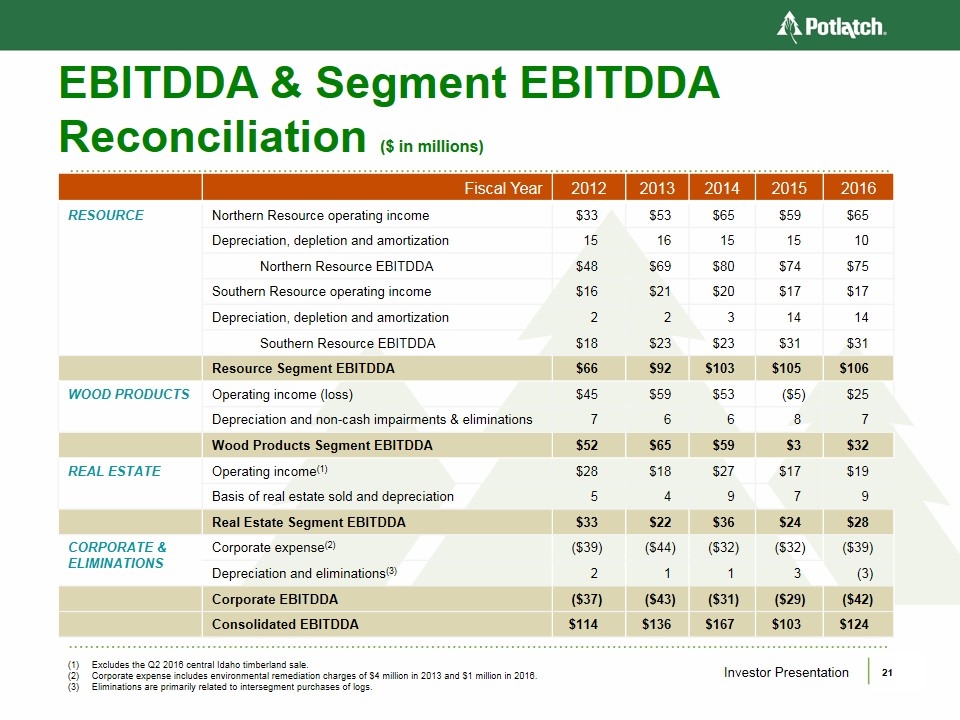
EBITDDA & Segment EBITDDA Reconciliation ($ in millions) Fiscal Year 2012 2013 2014 2015 2016 RESOURCE Northern Resource operating income $33 $53 $65 $59 $65 Depreciation, depletion and amortization 15 16 15 15 10 Northern Resource EBITDDA $48 $69 $80 $74 $75 Southern Resource operating income $16 $21 $20 $17 $17 Depreciation, depletion and amortization 2 2 3 14 14 Southern Resource EBITDDA $18 $23 $23 $31 $31 Resource Segment EBITDDA $66 $92 $103 $105 $106 WOOD PRODUCTS Operating income (loss) $45 $59 $53 ($5) $25 Depreciation and non-cash impairments & eliminations 7 6 6 8 7 Wood Products Segment EBITDDA $52 $65 $59 $3 $32 REAL ESTATE Operating income(1) $28 $18 $27 $17 $19 Basis of real estate sold and depreciation 5 4 9 7 9 Real Estate Segment EBITDDA $33 $22 $36 $24 $28 CORPORATE & ELIMINATIONS Corporate expense(2) ($39) ($44) ($32) ($32) ($39) Depreciation and eliminations(3) 2 1 1 3 (3) Corporate EBITDDA ($37) ($43) ($31) ($29) ($42) Consolidated EBITDDA $114 $136 $167 $103 $124 Excludes the Q2 2016 central Idaho timberland sale. Corporate expense includes environmental remediation charges of $4 million in 2013 and $1 million in 2016. Eliminations are primarily related to intersegment purchases of logs. Investor Presentation 21
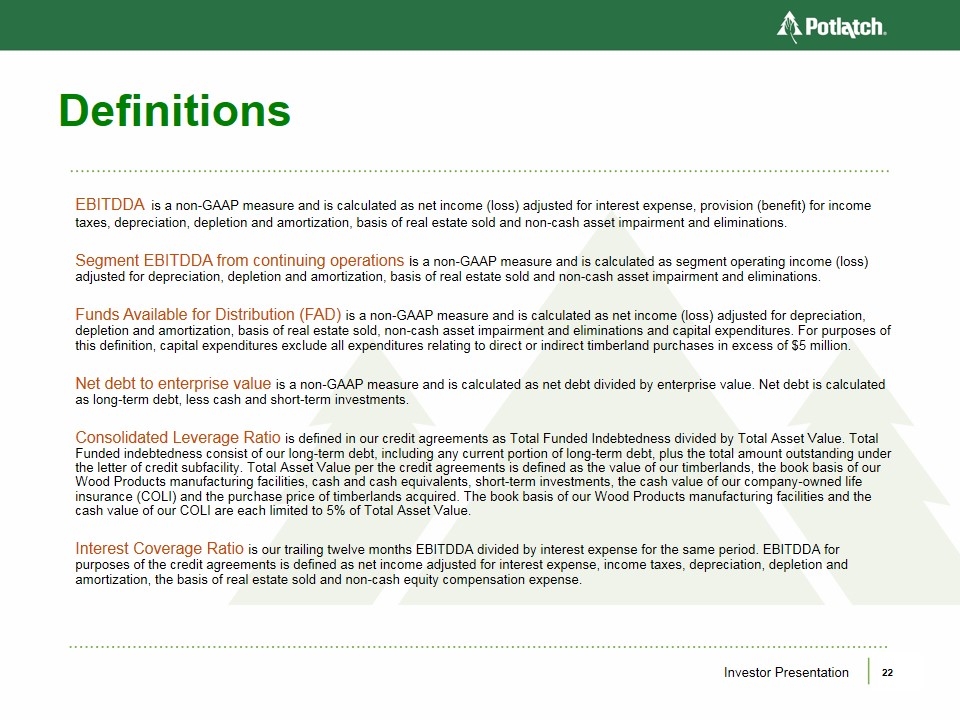
Definitions EBITDDA is a non-GAAP measure and is calculated as net income (loss) adjusted for interest expense, provision (benefit) for income taxes, depreciation, depletion and amortization, basis of real estate sold and non-cash asset impairment and eliminations. Segment EBITDDA from continuing operations is a non-GAAP measure and is calculated as segment operating income (loss) adjusted for depreciation, depletion and amortization, basis of real estate sold and non-cash asset impairment and eliminations. Funds Available for Distribution (FAD) is a non-GAAP measure and is calculated as net income (loss) adjusted for depreciation, depletion and amortization, basis of real estate sold, non-cash asset impairment and eliminations and capital expenditures. For purposes of this definition, capital expenditures exclude all expenditures relating to direct or indirect timberland purchases in excess of $5 million. Net debt to enterprise value is a non-GAAP measure and is calculated as net debt divided by enterprise value. Net debt is calculated as long-term debt, less cash and short-term investments. Consolidated Leverage Ratio is defined in our credit agreements as Total Funded Indebtedness divided by Total Asset Value. Total Funded indebtedness consist of our long-term debt, including any current portion of long-term debt, plus the total amount outstanding under the letter of credit subfacility. Total Asset Value per the credit agreements is defined as the value of our timberlands, the book basis of our Wood Products manufacturing facilities, cash and cash equivalents, short-term investments, the cash value of our company-owned life insurance (COLI) and the purchase price of timberlands acquired. The book basis of our Wood Products manufacturing facilities and the cash value of our COLI are each limited to 5% of Total Asset Value. Interest Coverage Ratio is our trailing twelve months EBITDDA divided by interest expense for the same period. EBITDDA for purposes of the credit agreements is defined as net income adjusted for interest expense, income taxes, depreciation, depletion and amortization, the basis of real estate sold and non-cash equity compensation expense. Investor Presentation 22
